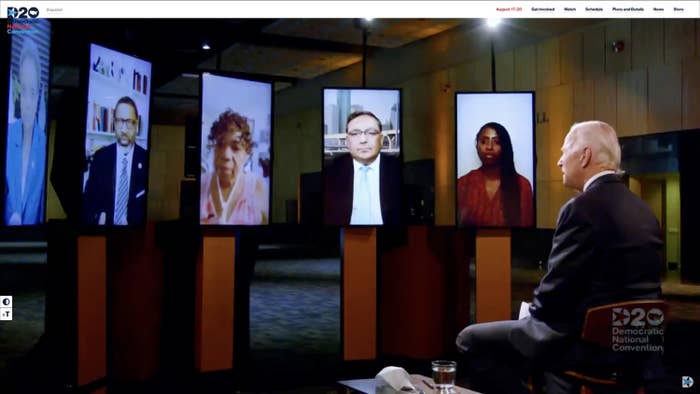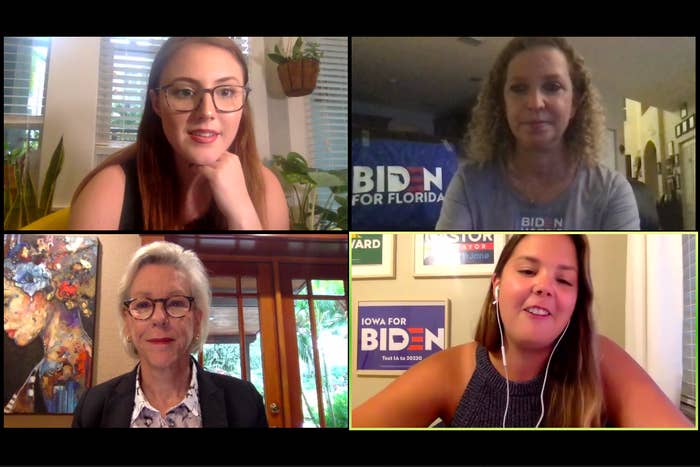
It was just past 7 p.m. on the opening night of the Democratic National Convention. Instead of working her way into a basketball arena, Rep. Debbie Wasserman Schultz was in her poorly lit family room, dialed into a Zoom videoconference. The picture on her end was a little blurry, but those tuned in could see the strips of tape holding her Joe Biden sign to an armchair.
The Florida lawmaker and former national party chair acknowledged how weird it all was. And then, from their respective squares onscreen, she and Tampa Mayor Jane Castor — and briefly Castor’s dog, barking in the background — launched a Women for Biden phone bank.
The coronavirus has reduced a four-day convention to a work-from-home webinar. Democrats who had planned to gather in Milwaukee and keep a packed schedule of party-building meetings are instead submitting themselves to the awkwardness and improvisation of webcasts and to the mercy of their internet connections. Video segments and big speeches, many of them prerecorded from remote locations, are airing in primetime, but without the applause of a large live audience of delegates who under normal circumstances would return to their communities amped to get out the vote for the general election.
All of this makes it tough to measure what success would look like.
“I think that 99% of the people only experience the convention on television,” Nancy Patton Mills, chair of the Pennsylvania Democratic Party, told BuzzFeed News last week in a telephone interview. “In other words, I don’t think that it’s something where, if we do something wrong, we lose.”
Fewer people are watching the convention on TV anyway. Live ratings for Monday night were down about 25% compared to 2016, but Biden’s campaign reported more than 10 million views on streaming platforms, up from what they said was 3 million streaming views on opening night in 2016. Democrats see digital campaigning as the future and optimistically are using this week’s events as an opportunity to figure out what works.
Barring a swift and unforeseen retreat of a pandemic that has killed more than 170,000 Americans, Biden’s team and other party leaders do not plan to engage in door-to-door canvassing or in-person events. The virtual format means that not only can people experience the conventions on TV, they can experience them through Zoom watch parties — and through the once-exclusive delegate breakfasts, lunches, and afterparties that draw big speakers. State parties in some cases are throwing open the virtual doors to anyone who provides an email address, phone number, and other data helpful for organizing.
“It’s like a broader democratization of the DNC in a way,” said Annie Levene, a partner at Rising Tide Interactive, a digital marketing agency that works with Democratic campaigns.
Biden, addressing Florida delegates during a virtual event Tuesday afternoon, said they were part of history.
“You’re part of the most creative, inclusive convention we’ve ever had,” Biden told them, according to a pool report. “I doubt we’ll ever go back to the same exact conventions we had in the past. It’s a template for the future.”
The Biden campaign has initiated watch parties in all 50 states this week, recruiting former 2020 presidential candidates such as New Jersey Sen. Cory Booker and former South Bend mayor Pete Buttigieg and actors such as Connie Britton and BD Wong to headline them.
President Donald Trump and Republicans also scaled back plans for their convention next week, originally set for Charlotte and Jacksonville. The specifics of next week’s Republican National Convention are not yet public, though Trump plans to give his speech accepting the party’s nomination at the White House. Trump’s supporters insist they have a robust in-person field operation in spite of the coronavirus. (A New York magazine piece this week found purported canvassing activities in battleground Pennsylvania to be nonexistent.)

"Joe Biden and our party have put the health and safety of the American people first,” said Biden national press secretary Jamal Brown, who added that the campaign “followed the science, listened to doctors and public health experts, and ensured voters have the resources they need to safely cast their ballot” for Biden and running mate Kamala Harris.
Back in March, when Biden held his last full-scale rally, no one knew how long traditional campaign activities would remain unsafe. Since then, the former vice president has conducted nearly 50 virtual events via Zoom or other digital platforms and about 20 in-person speeches or news conferences, usually in front of a small room of reporters and occasionally carried on TV. Biden video content has received more than a half-billion views on social media platforms over the last five months, according to the campaign.
Organizing and voter outreach since then has similarly occurred online and by telephone. Biden campaign officials and other party leaders told BuzzFeed News that they have been experimenting with digital tactics for months. The thought is that because of the pandemic, voters would rather receive a call or a text message than a knock at their door.
“What I have been hearing is, because people are still at home, the connects were really, really high,” said Levene. “So you’re able to have much more effective phone banking, and as people are signing up for all these virtual events, you’re gonna get data from that. Your phone number, your address — all of that stuff is really important, especially if we’re looking at vote-by-mail.”
State party chairs who spoke with BuzzFeed News see other benefits in the approach.
“This virtual program is the great equalizer,” said Felecia Rotellini, the Democratic chair in Arizona, a Trump state in 2016 that Biden is aggressively trying to flip. “If we were in a business-as-usual election cycle right now, we would have a lot of our rural communities, particularly the Democrats in the Republican counties, frustrated and angered that they can’t get candidates to come see them, that they’re working so hard to get Democrats elected and they don’t have the same accessibility to the candidates. And with this virtual platform, you could be in the furthest parts of Arizona, in Navajo County or Greenlee County, and you can have … virtually the same access as if you lived in the heart of Maricopa County.”
Wayne Goodwin, chair of the state party in North Carolina, another Biden target, said the emphasis on digital organizing is a case of the future tactics arriving sooner than expected.
“We essentially have leapfrogged over to what would have been many years down the road,” Goodwin said. “Even though so many of us would love to have the in-person opportunities, those will come back once we tackle this pandemic. But this is a new tool in the toolbox.”
David Pepper, chair of the Ohio Democratic Party, bragged about how his recent virtual state convention featured appearances by Biden, Harris, Booker, House Speaker Nancy Pelosi, and the actor Ed O’Neill, a native of Youngstown. The program has been viewed more than 15,000 times. “None of that would have happened,” Pepper said, at a typical in-person convention.
Many of the watch parties around this week’s convention are tied into phone banks and other organizing activities. And Biden campaign workers are following up with those who register for the events to recruit them for volunteer assignments. Campaign officials did not immediately provide registration numbers for Monday night’s phone bank with Wasserman Schultz. A pregame convention watch party with Michigan Democrats — headlined by Lt. Gov. Garlin Gilchrist and featuring a performance of Marvin Gaye’s “What’s Going On” by the Detroit Academy of Arts and Sciences Choir — drew several hundred viewers.
“No one should underestimate the power of a virtual communication,” former US secretary of state John Kerry, a prominent Biden surrogate, said Tuesday on a Zoom call with reporters. (Earlier in the call, an unmuted Kerry inadvertently illustrated the awkwardness of virtual communication when his coughing interrupted the deputy campaign manager’s remarks.)
“I mean, we're talking, you and I, right now,” Kerry added, “and I think that it may even eliminate some of the chaff and allow people to focus on the message and get things out with a clarity that you might not otherwise get in that, you know, back-and-forth of the other kind of retail [politics]. That's an experiment. We don't know the answer to that yet. We'll see what happens.”
Correction: Biden video content has received more than a half-billion views on social media platforms over the last five months. A previous version of this story misstated the number.
